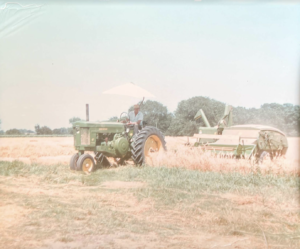One of the greatest inventions in history is the combine. The concept of threshing and separating grain in one operation revolutionized our food system, as well as redefined our labor force. Consider that in the mid-1800s, 90% of the US workforce was involved in some aspect of farming. Now it’s under 2%. To think my grandfather harvested corn by hand and threw the ears in a wagon! He used the pull-behind model in the 1940s to harvest small grains (that’s him, Fred Nichols, combining oats on our family farm). My mother still talks about dad wearing a Jesse James style mask while operating their first self-propelled combine without a cab.
Each combine contains hundreds of bearings, belts, fans, augers and motors – used in synchrony – to cut crops; gather, separate, clean and unload grain; chop up and size the stalks, leaves and other plant material; then distribute this residue evenly across the field. While all of these systems may seem imposing, many of the operations are now controlled by a single-lever joystick. Ergonomically designed to fit comfortably in your hand, you can use it to move the machine forwards and backwards, control your speed, engage an auto-steer feature that uses GPS guidance to automatically drive and steer the machine, move your header up and down or side to side, unfold your unloading auger and dump your grain. Growing up, it would take about a day or better to harvest an 80-acre field. And changing over from a corn header to a grain platform took at least half a day; header changeovers and adjustments can be made in minutes. Today’s high-performance combines can harvest over 30 acres per hour. Yet they come with price tags of $600,000-800,000. That’s why you still see a lot of older models running. Speaking from lots of experience, combines are an absolute blast to drive (until they break down and you have to repair them, that is).
It’s #NationalPorkMonth. Few segments have changed more drastically in my lifetime than swine production. Growing up in western Illinois, nearly every farmer raised hogs. They were called mortgage lifters, as pigs generated positive cash flow multiple times per year (every FFA student knows the gestation period of a sow is 3 months, 3 weeks and 3 days) and added extra money to the family coffers. Some of my most memorable – note I did not say fondest – times growing up on the farm involved working with hogs. This includes shoveling manure from the farrowing house and pulling all-nighters during the birth of piglets. We never had a garbage disposal growing up, I carried out the leftovers in a bucket and slopped them over the fence. For my efforts, dad bought me a gilt of my choosing. I selected a red one, a duroc. After delivering a fine-looking litter of eight pigs, she managed to eat every one of her offspring. That abruptly ended my aspirations to become a pork producer. Swine production has since evolved from what once was a lot of small-scale operations to large integrated systems, much like the poultry business. US hog inventories stand at about 72 million. Swine is a huge market for corn growers. Even at a feed efficiency of 3 pounds of feed per pound of gain, pigs eat lots of corn. Pigs consume about one out of every five bushels of corn grown in Iowa. And can I just say, there’s nothing like an Iowa pork chop!
Another week, another commitment among major food companies to provide products grown using regenerative agriculture practices. This time it’s between General Mills and Walmart, who have pledged to accelerate 600,000 acres into #regenag by 2030. This accounts for all the acres General Mills sources in making products sold through Wal-Mart. Motivations include improving soil health, water quality and carbon sequestration across their shared value chain.
Foreign farmland ownership, specifically among nations viewed as adversarial to US interests, has been a political hot button. The message of “food security is national security” has been a popular message in many circles. The issue figures to heat up on the news last week that Arkansas has banned Chinese companies from owning farmland in the Natural State. The effect of the legislation extends beyond Chinese citizens and the government. Life sciences giant Syngenta is now owned by ChemChina. One of their subsidiaries is Northrup King. NK has a rich history in the seed business and is a large player (my dad sold for them years ago). NK owns a 160-acre research farm, which they now have two years to divest. Syngenta was also fined $280,000 for not reporting its foreign ownership under a 2021 law. Collectively, foreign interests own about 35 million acres of US farmland, about the size of Iowa. But that number has doubled from 2009-2019. USDA projects the Chinese own 380,000 acres, about 0.03% of all US farmland and less than 1% of all foreign-owned land. However, many believe those figures are deflated. It’s only a matter of time before other states follow the recent Arkansas legislation; 24 states currently have some limitations. And there’s strong support among the constituents within many leading farm states.
More evidence that those black soils can be very forgiving. A good friend of mine who farms in multiple counties across western Illinois told me his corn is averaging 240 bu/A, despite receiving almost no rain until July. My cousin reported an incredible yield of 268 bu/A on a 74-acre field. As I’ve noted from personal experience, July rains during pollination can make a corn crop. This lack of moisture also underscores the importance of soil health and fertility. Farmers in western Illinois are blessed with rich Muscatine soils, while those in eastern Illinois enjoy the famous Drummer soils. But for most US farmers, fertile soils aren’t gifted, they must be made and then sustained. Soil health practices are critical. That’s where humic products can play a key role. The richer and healthier the soil, the better its ability to handle abiotic stress.
On Thursday, Continuum Ag will be hosting their next TopSoil webinar. The guest is Liz Hainey. She and Mitchell will be talking about regenerative agriculture. You can register here.
Huma is proud to sponsor the inaugural RANCON – hosted by start-up ag retailer RegenAg Nation – in Boise next Wednesday. The event focuses on utilizing regen ag practices for “Building Tomorrow’s Yields Today.”
Related Posts

The Road to Sustainability
“Sustainability is a way of thinking: At Huma® we’ve been thinking sustainably for over 50 years.” We make that statement at the top of the Sustainability section of our Huma® Website. And we stand by it. But what, exactly, does it mean? Over the past 50 years, we at Huma® have always striven to create products that work with nature in support of the well-being of our planet and our customers and to create a working environment that supports the well-being of our staff members and their families. We were doing this long before sustainability became the “thing” that it is now.

Corn Records Without Rewards
Corn Records Without Rewards U.S. corn growers are smashing records in acreage and yield, but instead of golden returns, many are facing low prices and soaring input costs. Record bushels don’t always mean record profits.

Discover Three Products to Prep Your Soil for Spring Planting
As I begin to write, I’m reminded of an excerpt from Ode to the West Wind — “If winter comes, can spring be far behind?” Well, spring is certainly not far behind, especially for those of us working in the agriculture sector. Winter can be a tricky time for growers, as many of them face



